2012届高考英语一轮复习教案Module3BodyLanguageandNon-verbalCommunication(外研版必修4)
高考英语一轮复习 Module3 BodyLanguageandNonverbalCommunication教学案 外研版必修4
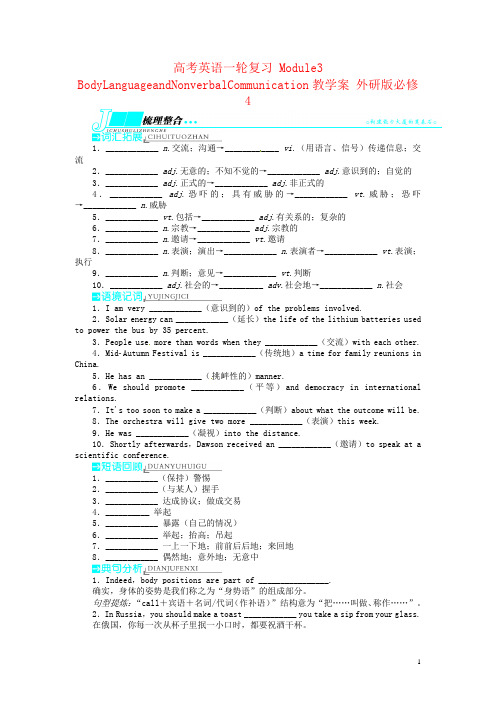
高考英语一轮复习 Module3 BodyLanguageandNonverbalCommunication教学案外研版必修41.____________ n.交流;沟通→____________ vi.(用语言、信号)传递信息;交流2.____________ adj.无意的;不知不觉的→____________ adj.意识到的;自觉的3.____________ adj.正式的→____________ adj.非正式的4.____________ adj.恐吓的;具有威胁的→____________ vt.威胁;恐吓→____________ n.威胁5.____________ vt.包括→____________ adj.有关系的;复杂的6.____________ n.宗教→____________ adj.宗教的7.____________ n.邀请→____________ vt.邀请8.____________ n.表演;演出→____________ n.表演者→____________ vt.表演;执行9.____________ n.判断;意见→____________ vt.判断10.____________ adj.社会的→__________ adv.社会地→____________ n.社会1.I am very ____________(意识到的)of the problems involved.2.Solar energy can ____________(延长)the life of the lithium batteries used to power the bus by 35 percent.3.People use more than words when they ____________(交流)with each other.4.MidAutumn Festival is ____________(传统地)a time for family reunions in China.5.He has an ____________(挑衅性的)manner.6.We should promote ____________(平等)and democracy in international relations.7.It's too soon to make a ____________(判断)about what the outcome will be.8.The orchestra will give two more ____________(表演)this week.9.He was ____________(凝视)into the distance.10.Shortly afterwards,Dawson received an ____________(邀请)to speak at a scientific conference.1.____________(保持)警惕2.____________(与某人)握手3.____________ 达成协议;做成交易4.__________ 举起5.____________ 暴露(自己的情况)6.____________ 举起;抬高;吊起7.____________ 一上一下地;前前后后地;来回地8.____________ 偶然地;意外地;无意中1.Indeed,body positions are part of ________________.确实,身体的姿势是我们称之为“身势语”的组成部分。
Module-3-Body-Language-and-Non-verbal-Communication-教案
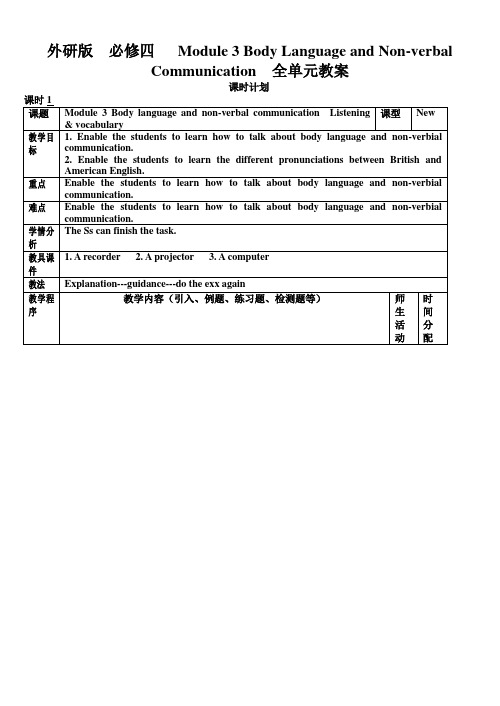
外研版必修四Module 3 Body Language and Non-verbalCommunication 全单元教案课时计划课时1课题Module 3 Body language and non-verbal communication Listening& vocabulary课型New教学目标1. Enable the students to learn how to talk about body language and non-verbial communication.2. Enable the students to learn the different pronunciations between British and American English.重点Enable the students to learn how to talk about body language and non-verbial communication.难点Enable the students to learn how to talk about body language and non-verbial communication.学情分析The Ss can finish the task.教具课件1. A recorder2. A projector3. A computer教法Explanation---guidance---do the exx again教学程序教学内容(引入、例题、练习题、检测题等)师生活动时间分配Step 1Step 2Revision1 Proof readingPractice(1) Only in this way ___________ progress in your English. (MET84) (B)A. you makeB. can you makeC. you be able to makeD. will youable to make(2) He is the only one of the students who ___ a winner of scholarship for threeyears. (沪2002春招) (D)A. isB. areC. have beenD. has been(3) Only then ___________ the importance of health. 只有那时我才认识到健康的重要性。
(新)高考英语一轮复习第1部分Module3BodyLanguageandNon-verbalCommunication课堂达标外研版必修4

Module 3 Body Language and Nonverbal CommunicationⅠ.用所给词的适当形式填空导学号 580823821.There are _varieties__(vary) of plants in the botanic garden.2.Although I received an _invitation__(invite) to the ball, I didn't want to attend it.3.Their father divided a small inheritance(遗产) _equally__ (equal) between them.4.Attending _social__ (society) activities can improve your confidence before others.5.He didn't take his parents' advice and was soon _involved__(involve) in trouble.6.The little boy _panicked__(panic) when thinking about the punishment he might get from his master.7.The driver was _unconscious__ (conscious) for three days in the hospital after the accident.8.She became dumb because of illness three years ago, and now she is used to _communicating__(communicate) with sign language.Ⅱ.介、副词填空导学号 580823831.I'm afraid the kids would give the whole thing _away__.2.The teacher held _up__ his hand, signing the students to stop their discussion.3.Who was _on__ guard when the fire broke out?4.The house caught fire on purpose rather than _by__ accident.5.He hurt his arms while lifting _up__ a heavy box.Ⅲ.句型训练导学号 580823841.句型转换(1)If weather permits, they will go for an outing tomorrow.→_Weather_permitting__ , they will go for an outing tomorrow.(2)It is difficult to understand what he said.→What he said is difficult _to_understand__.2.完成句子(1)他不仅仅是我们的老师,也是我们的朋友。
高考英语一轮复习Module3BodyLanguageandNon_verbalCommuni
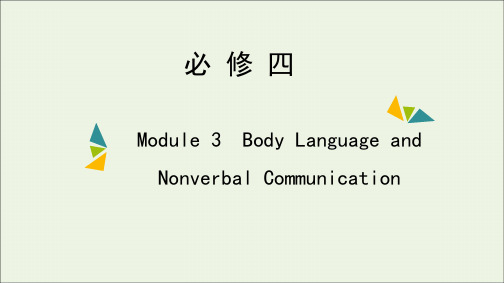
2.involve vt.包括;涉及;使参与;需要
(1)involve sb.in (doing)sth. 使某人参与(做)某事;使某人牵扯到某事中
involve doing sth.
包括做某事;参与做某事
(2)involved adj.
复杂的;有牵连的,有关的
get/be involved in
3.“偶然地”和“故意地”短语集锦
①by accident
偶然地
②by chance
偶然地
③by design
故意地
④on purpose
故意地
【构词记忆】 以不发音字母 e 结尾的动词,常去掉 e 再加上“-ation”构成名词 ①invite 邀请→invitation 邀请 ②admire 羡慕→admiration 羡慕 ③continue 继续→continuation 继续 ④examine 检查→examination 考试 ⑤imagine 想象→imagination 想象 ⑥observe 观察→observation 观察 ⑦organize 组织→organization 组织
9.equal adj.平等的;相等的→_e_q_u_a_ll_y_ adv.平等地;相等地→_e_q_u_a_l_it_y_ n.平等
10.vary vi.变化→_v_a_r_ie_t_y_ n.种类→_v_a_r_io_u_s_ adj.各种各样的 11.invite v.邀请→__in_v_i_ta_t_io_n__ n.邀请
7.perform v.表演→_p_e_rf_o_r_m_e_r_ n.表演者→_p_e_rf_o_r_m_a_n_c_e_ n.表演 8.tradition n.传统→__tr_a_d_it_i_o_n_al__ adj.传统的→__t_r_ad_i_t_io_n_a_l_ly__ adv.传统 地
高考英语一轮复习 第一部分 教材课文要点 Module 3 Body Language and No
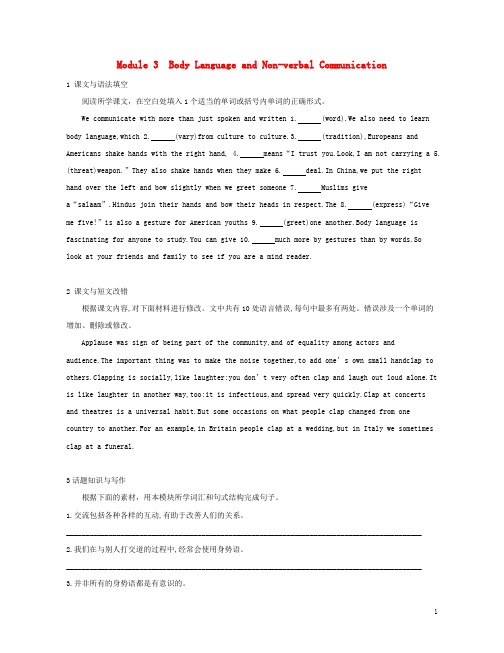
Module 3 Body Language and Non-verbal Communication1 课文与语法填空阅读所学课文,在空白处填入1个适当的单词或括号内单词的正确形式。
We communicate with more than just spoken and written 1. (word).We also need to learn body language,which 2. (vary)from culture to culture.3. (tradition),Europeans and Americans shake hands with the right hand, 4. means“I trust you.Look,I am not carrying a 5. (threat)weapon.”They also shake hands when they make 6.deal.In China,we put the right hand over the left and bow slightly when we greet someone 7. Muslims givea“salaam”.Hindus join their hands and bow their heads in respect.The 8.(express)“Give me five!”is also a gesture for American youths 9.(greet)one another.Body language is fascinating for anyone to study.You can give 10. much more by gestures than by words.So look at your friends and family to see if you are a mind reader.2 课文与短文改错根据课文内容,对下面材料进行修改。
高中英语一轮复习-Module-3-Body-Language-and-Non-verbal-Com

6
实际上,身体姿态就是我们称之为“身势语” 一部分。
2/6
2
重点句型
3. Body language is fascinating for anyone to study. 身势语对于任何要学它人来说都是迷人。
3/6
3
句型探究
1.When in Rome, Do as Romans Do 入乡随俗 When in Rome= When you are in Rome,是时 间状语从句省略结构,省略了主语和be 动词。 为了简练,有些状语从句(如时间状语从句、 条件状语从句、方式状语从句、让步状语从句 等),当从句主语与主句主语一致,且从句谓语有 动词be 时,能够省去从句中主语和be 动词;当从 句主语是it,谓语动词中又含有系动词be 时,能够 把it与be一起省略。
4/6
4
句型探究
He fell asleep while (he was ) doing his homework. 他在做作业时睡着了。 Though (he was)tired, he went on practising it. 即使很疲劳,可他依然继续练习。 You can turn to him for help when (it is) necessary. 必要时,你能够向他求援。 If (it is ) possible, I wish to go there next week. 假如有可能Leabharlann ,我希望下周去那儿。5/6
5
句型探究
2. Indeed, body positions are part of what we call “body language”.
实际上,身体姿态就是我们称之为“身势语”一部 分。
外研高中英语必修4教案Module 3Module 3 Body Language and Nonverbal Communication
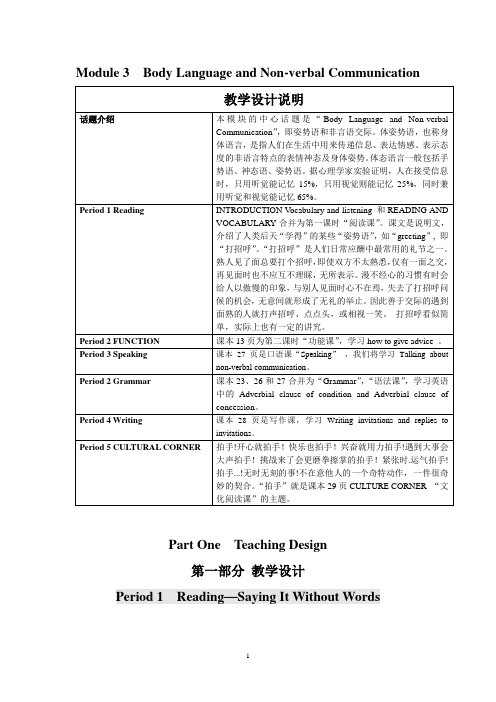
Module 3 Body Language and Non-verbal CommunicationPart One Teaching Design第一部分教学设计Period 1 Reading—Saying It Without Words■Goals●To learn to read passages with Adverbial clause of conditionand Adverbial clause of concession about body language●To learn to read with strategies■ProceduresStep 1: Warming up by defining Body LanguageBody language is a broad term for several forms of communication using body movements or gestures, instead of, or as a complement to, sounds, verbal language, or other forms of communication. In turn, it is one category of paralanguage, which describes all forms of human communication that are not language.Warming up by telling about your classmate’s body languageHi, class. Look at my facial expressions. What do I mean by these expressions?Now, look around and tell the class what you find by studying your classmates’body language.Step 2: Before you readPlease go over the word list for this module, paying attention to the pronunciationof the word, the relationship between its pronunciation and its spelling.Step 3: While you read1.Type of writing and summaries of Saying It Without Words2. A diagram of Saying It Without Words3. Complete the article with one word in each blank.We find examples of _1_ body language very often, yet there is also “learned” body language, which is different from _2_ to culture.Every culture has turned out a _3_ way to greet strangers, to show them we are not aggressive. Traditionally, Europeans and Americans _4_ hands when greeting strangers. Traditionally in China, we see people putting the right _5_ over the left and bowing slightly. Muslims give a “salaam”. That is touching their heart, _6_ and forehead. Hindus join their hands and bow their heads in respect. American youths often _7_ each other with the expression, “Give me five!” One person then holds up his hand, palm _8_ and five fingers spread. The other person raises his hand and slaps the other’s open hand _9_ the head in a “high five”. Body language is fascinating for anyone to study. People give away _10_ more by their gestures than by their words.1. Is unconscious body language a kind of “learned” body language?A. No.B. Yes.C. Maybe.D. Sure2. We use “learned” body language when we are _____.A. introduced to strangersB. greeting someoneC. carrying a weaponD. busy with the talking3. Greetings in _____ countries do not involve touching the other person.A. AfricanB. EuropeanC. AmericanD. Asian4. What does the phrase “give away” mean in the sentence “People give away much more by their gestures than by their words.”?A. expressB. offerC. sendD. findPeriod 2 Grammar—Adverbial clause of condition andAdverbial clause of concession■Goals●To learn to understand and use Adverbial clause of condition and Adverbial clause of concession about body language■ProceduresStep 1: Learning about Adverbial clause of condition引导条件状语从句的连词和词组有if,unless,once,as / so long as,so / as far as,in case,provided (that),providing (that),suppose (that),supposing (that),given (that),assuming (that),on condition (that)等。
高考英语一轮复习 第一部分 教材课文要点 Module 3 Body Language and No
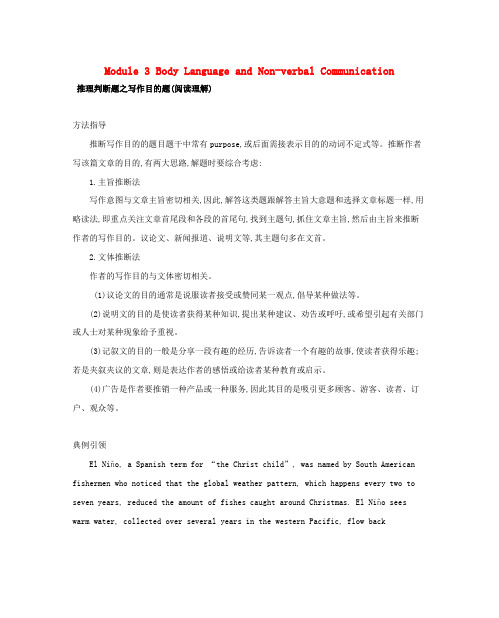
Module 3 Body Language and Non-verbal Communication推理判断题之写作目的题(阅读理解)方法指导推断写作目的的题目题干中常有purpose,或后面需接表示目的的动词不定式等。
推断作者写该篇文章的目的,有两大思路,解题时要综合考虑:1.主旨推断法写作意图与文章主旨密切相关,因此,解答这类题跟解答主旨大意题和选择文章标题一样,用略读法,即重点关注文章首尾段和各段的首尾句,找到主题句,抓住文章主旨,然后由主旨来推断作者的写作目的。
议论文、新闻报道、说明文等,其主题句多在文首。
2.文体推断法作者的写作目的与文体密切相关。
(1)议论文的目的通常是说服读者接受或赞同某一观点,倡导某种做法等。
(2)说明文的目的是使读者获得某种知识,提出某种建议、劝告或呼吁,或希望引起有关部门或人士对某种现象给予重视。
(3)记叙文的目的一般是分享一段有趣的经历,告诉读者一个有趣的故事,使读者获得乐趣;若是夹叙夹议的文章,则是表达作者的感悟或给读者某种教育或启示。
(4)广告是作者要推销一种产品或一种服务,因此其目的是吸引更多顾客、游客、读者、订户、观众等。
典例引领El Niño, a Spanish term for “the Christ child”, was named by South American fishermen who noticed that the global weather pattern, which happens every two to seven years, reduced the amount of fishes caught around Christmas. El Niño sees warm water, collected over several years in the western Pacific, flow backeastwards when winds that normally blow westwards weaken, or sometimes the otherway round.The weather effects, both good and bad, are felt in many places. Rich countries gain more from powerful Niños, on balance, than they lose. A study found that a strong Niño in 1997-98 helped America’s economy grow by$15 billion, partly because of better agricultural harvests:farmers in the Midwest gained from extra rain. The total rise in agricultural incomes in rich countries is greater than the fall in poor ones.But in Indonesia extremely dry forests are in flames. A multi-year drought(干旱)in south-east Brazil is becoming worse. Though heavy rains brought about by ElNiño may relieve the drought in Californ ia, they are likely to cause surfaceflooding and other disasters.The most recent powerful Niño, in 1997-98, killed around 21,000 people and caused damage worth$36 billion around the globe. But such Niños come with months of warning, and so much is known about how they happen that governments can prepare. According to the Overseas Development Institute (ODI), however, just 12% ofdisaster-relief funding in the past two decades has gone on reducing risks in advance, rather than recovery and rebuilding afterwards. This is despite evidence that a dollar spent on risk-reduction saves at least two on reconstruction.Simple improvements to infrastructure(基础设施)can reduce the spread of disease. Better sewers(下水道)make it less likely that heavy rain is followed by an outbreak of the disease of bad stomach. Stronger bridges mean villages are less likely to be left without food and medicine after floods. According to a paper in 2011 by Mr Hsiang and co-authors, civil conflict is related to El Niño’s harmful effects—and the poorer the country, the stronger the link. Though the relationship may not be causal, helping divided communities to prepare for disasters would at least reducethe risk that those disasters are followed by killing and wounding people. Since the poorest are least likely to make up for their losses from disasters linked to El Niño, reducing their losses needs to be the priority.1.What can we learn about El Niño in Paragraph 1?A.It is named after a South American fisherman.B.It takes place almost every year all over the world.C.It forces fishermen to stop catching fish around Christmas.D.It sees the changes of water flow direction in the ocean.2.What may El Niños bring about to the countries affected?A.Agricultural harvests in rich countries fall.B.Droughts become more harmful than floods.C.Rich countries’ gains are greater than their losses.D.Poor countries suffer less from droughts economically.3.The data provided by ODI in Paragraph 4 suggest that .A.more investment should go to risk reductionernments of poor countries need more aidC.victims of El Niño deserve more compensationD.recovery and reconstruction should come first4.What is the author’s purpose in writing the passage?A.To introduce El Niño and its origin.B.To explain the consequences of El Niño.C.To show ways of fighting against El Niño.D.To urge people to prepare for El Niño.方法运用[语篇解读] 本文是一篇说明文,主要介绍了厄尔尼诺现象名称的由来、发生的时间、造成的影响,督促人们加强风险前资金的投入,改进基础设施,为厄尔尼诺现象的发生做好准备。
高考英语复习Module3BodyLanguageandNon_verbalCommunication学案外研版
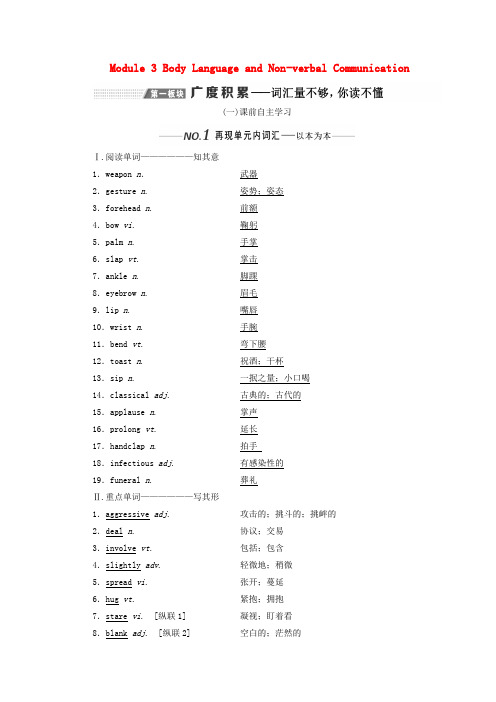
Module 3 Body Language and Non-verbal Communication(一)课前自主学习Ⅰ.阅读单词——————知其意1.weapon n.武器2.gesture n. 姿势;姿态3.forehead n. 前额4.bow vi.鞠躬5.palm n. 手掌6.slap vt.掌击7.ankle n. 脚踝8.eyebrow n. 眉毛9.lip n. 嘴唇10.wrist n. 手腕11.bend vt.弯下腰12.toast n. 祝酒;干杯13.sip n. 一抿之量;小口喝14.classical adj.古典的;古代的15.applause n. 掌声16.prolong vt.延长17.handclap n. 拍手18.infectious adj.有感染性的19.funeral n. 葬礼Ⅱ.重点单词——————写其形1.aggressive adj.攻击的;挑斗的;挑衅的2.deal n. 协议;交易3.involve vt.包括;包含4.slightly adv.轻微地;稍微5.spread vi.张开;蔓延6.hug vt.紧抱;拥抱7.stare vi.[纵联1] 凝视;盯着看8.blank adj. [纵联2] 空白的;茫然的9.panic v. [纵联3] 恐慌;惊慌10.rude adj.粗鲁的;无礼的11.invitation n. 邀请12.request n. [纵联4] 请求;要求13.live adj. [纵联5] 现场的Ⅲ.拓展单词——————通其变1.communicate vi.(用语言、信号)传递信息;交流→communication n.交流;沟通2.vary vi.变化;(大小、形状等)相异→various adj.各种各样的→variety n.变化;多样化;种类→variable adj.易变的;变化的3.traditionally adv.传统地→traditional adj.传统的→tradition n.传统4.threatening adj.恐吓的;具有威胁的→threaten vt.威胁→threat n.威胁5.conscious adj.意识到的;自觉的→unconscious adj.无意识的;不知不觉的6.favour n.恩惠;善意的行为;支持;赞同→favourable adj.赞同的;有利的→favourite adj.& n.特别喜爱的(东西)7.performance n.表演→performer n.表演者→perform v.表演8.equality n.平等→equal adj.平等的;相等的→equally adv.平等地;相等地纵联1.不一样的“看”①stare vi.凝视;盯着看②glare v.怒目而视③glance v.一瞥;扫视④watch v.观看⑤notice v.注意到⑥observe v.观察⑦gaze v.凝视;注视⑧glimpse v.瞥见纵联2.这些都是“空的”①blank空白的;茫然的②empty空的;空洞的③vacant空的;空缺的④hollow空的;空心的纵联3.“惊恐”万状①panic n.& v.惊慌,恐慌②alarm n.& v.使惊恐,警告③frighten vt.使害怕,吓唬④horror n.惊恐,恐怖⑤terror n.恐怖,惊骇⑥shock n.& vt.震惊,使吃惊纵联4.“请求;要求”有很多①request n.& v.请求;要求②ask v.请求;要求③beg v.请求;乞求④require v.要求;需求⑤demand n.& v.要求;请求⑥appeal v.恳求;呼吁纵联5.由live所想到的①live adj.现场的②lively adj.活泼的;生机勃勃的③living adj.活的;现存的④alive adj.活的;有活力的单元话题——肢体语言子话题1 交流方式①greet v.问候;打招呼②shake one's head摇头③eye contact目光接触④sign language手语⑤facetoface communication 面对面交流⑥facial expression面部表情子话题2 行为、态度①apologise vi.道歉②appreciate vt.欣赏;感激③respond vi.回答;做出反应④interrupt v.打断,打扰⑤misunderstand vt.误解;误会⑥insult v.& n.侮辱⑦frown v.皱眉⑧yawn vi.打哈欠⑨nod n.& v.点头⑩clap n.& v.鼓掌;拍手⑪shrug v.耸肩⑫in response to响应;回答[学考对接·活学活用]高考采撷(一) 阅读中的词汇应用1.(2018·全国卷Ⅰ阅读C) Soon afterwards, many of those people started settling down to become farmers, and their languages too became more settled and fewer in number.In recent centuries, trade❶, industrialisation, the development of the nationstate and the spread❷of universal compulsory education, especially globalisation and better ❸ (communicate) in the past few decades, all have caused many languages to disappear, and dominant languages such as English, Spanish and Chinese are increasingly taking over.①写出trade在本单元中的同义词:deal,其近义词还有exchange②写出spread在句中的含义:扩展。
高考英语一轮复习 Module3 BodyLanguageandNonverbalCommunication教学案 外研版必修4
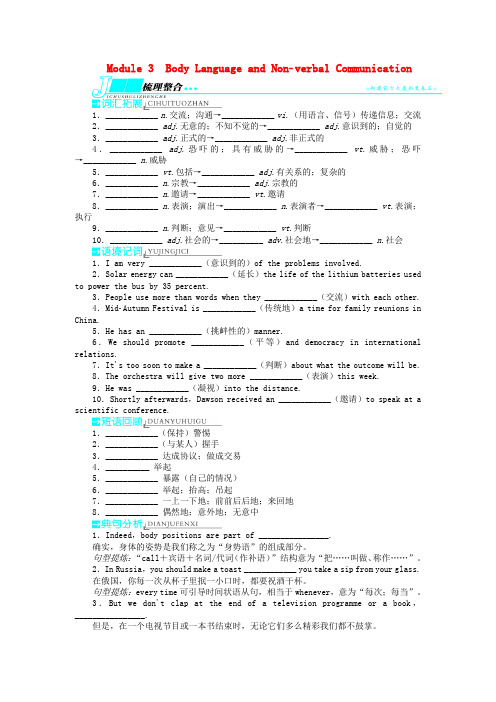
Module 3 Body Language and Nonverbal Communication1.____________ n.交流;沟通→____________ vi.(用语言、信号)传递信息;交流2.____________ adj.无意的;不知不觉的→____________ adj.意识到的;自觉的3.____________ adj.正式的→____________ adj.非正式的4.____________ adj.恐吓的;具有威胁的→____________ vt.威胁;恐吓→____________ n.威胁5.____________ vt.包括→____________ adj.有关系的;复杂的6.____________ n.宗教→____________ adj.宗教的7.____________ n.邀请→____________ vt.邀请8.____________ n.表演;演出→____________ n.表演者→____________ vt.表演;执行9.____________ n.判断;意见→____________ vt.判断10.____________ adj.社会的→__________ adv.社会地→____________ n.社会1.I am very ____________(意识到的)of the problems involved.2.Solar energy can ____________(延长)the life of the lithium batteries used to power the bus by 35 percent.3.People use more than words when they ____________(交流)with each other.4.MidAutumn Festival is ____________(传统地)a time for family reunions in China.5.He has an ____________(挑衅性的)manner.6.We should promote ____________(平等)and democracy in international relations.7.It's too soon to make a ____________(判断)about what the outcome will be.8.The orchestra will give two more ____________(表演)this week.9.He was ____________(凝视)into the distance.10.Shortly afterwards,Dawson received an ____________(邀请)to speak at a scientific conference.1.____________(保持)警惕2.____________(与某人)握手3.____________ 达成协议;做成交易4.__________ 举起5.____________ 暴露(自己的情况)6.____________ 举起;抬高;吊起7.____________ 一上一下地;前前后后地;来回地8.____________ 偶然地;意外地;无意中1.Indeed,body positions are part of ________________.确实,身体的姿势是我们称之为“身势语”的组成部分。
Module 3 Body Language and Non-verbal Communication词汇解读教学设计
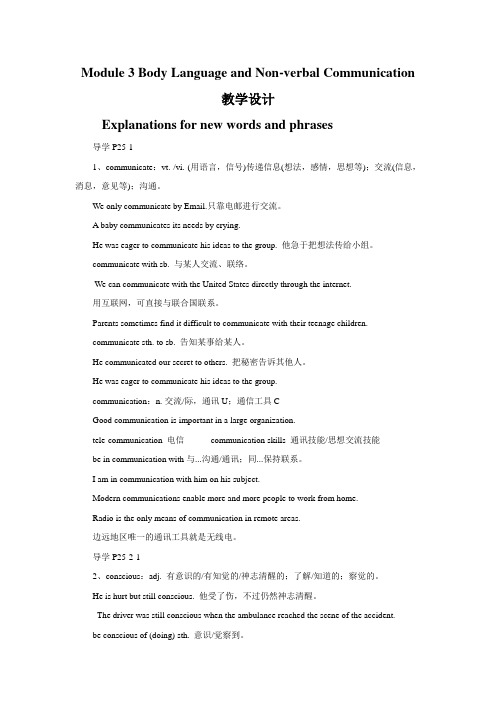
Module 3 Body Language and Non-verbal Communication教学设计Explanations for new words and phrases导学P25-11、communicate:vt. /vi. (用语言,信号)传递信息(想法,感情,思想等);交流(信息,消息,意见等);沟通。
We only communicate by Email.只靠电邮进行交流。
A baby communicates its needs by crying.He was eager to communicate his ideas to the group. 他急于把想法传给小组。
communicate with sb. 与某人交流、联络。
We can communicate with the United States directly through the internet.用互联网,可直接与联合国联系。
Parents sometimes find it difficult to communicate with their teenage children.communicate sth. to sb. 告知某事给某人。
He communicated our secret to others. 把秘密告诉其他人。
He was eager to communicate his ideas to the group.communication:n. 交流/际,通讯U;通信工具CGood communication is important in a large organization.tele-communication 电信communication skills 通讯技能/思想交流技能be in communication with与...沟通/通讯;同...保持联系。
高考英语一轮复习 Module 3 Body Language and Non-verbal Com
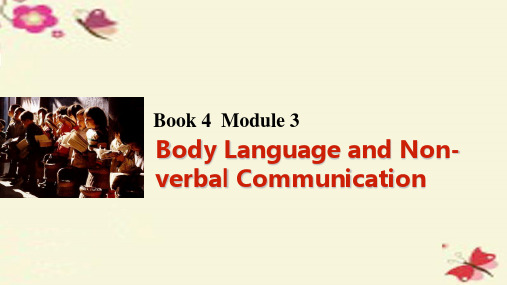
_擦__;__抹__;__揩__ _宗__教__ _主__人__ _祝__酒__;__干__杯__ _空__白__的__ _恐__慌__;__惊__慌__ _古__典__的__;__古__代__的__
答案
33.applause (n.) 34.funeral (n.) 35.unconscious (adj.) conscious (adj.) 36.threatening (adj.) threaten (v.) threat (n.)
from now on.
答案
返回
自主排查 夯实基础知识
重点单词
A.写作单词 1. deal (n.) 2. involve (vt.) 3. spread (vi.) 4.stare (vi.) 5.request (n.& v.)
协议;交易 包括 张开 凝视;盯着看 请求;要求
答案
6. favour(n.)
多词一义 varieties of,a variety of,all kinds of,different (1)vary from...to...由……到……不等 vary with随……变化 vary in在……方面变化 (2)a variety of=varieties of种种的;各种各样的 (3)various adj.各种各样的;不同的
平等地
14. communication (n.) 交流;沟通
communicate (vi.) (用语言、信号)传递信息;交流
答案
15. vary (vi.)
变化
various (adj.)
各种各样的
variety (n.)
种类
16.formal (adj.)
- 1、下载文档前请自行甄别文档内容的完整性,平台不提供额外的编辑、内容补充、找答案等附加服务。
- 2、"仅部分预览"的文档,不可在线预览部分如存在完整性等问题,可反馈申请退款(可完整预览的文档不适用该条件!)。
- 3、如文档侵犯您的权益,请联系客服反馈,我们会尽快为您处理(人工客服工作时间:9:00-18:30)。
2012届高考英语一轮单元总复习讲义精品荟萃外研版必修四Module3知识详解1 involve vt.包括;涉及;使参与(回归课本P22)Greetings in Asian countries do not involve touching the other person,but they always involve the hands.亚洲人打招呼是不包括接触他人身体的,但经常会用到手。
归纳总结例句探源①Every day each of us makes decisions that involve taking a chance.每天我们每个人作出的决定都包含碰运气的成分。
②(牛津P1078)I was so involved in my book that I didn’t hear you knock.我全神贯注在看书,没听到你敲门。
③Don’t involve me in your quarrel.不要把我卷入你们的争吵。
④Most people don’t realize the amount of effort that is involved in w riting a novel.大多数人都不明白写一本小说要花多少心血。
即境活用1.All the children were ________in the school English competition held on Sunday.A.attended B.joinedC.involved D.connected解析:选C。
句意为“所有的孩子都参加了学校星期天的英语竞赛”。
注意题中使用了被动结构,A、B首先被排除;D项常见的搭配是be connected to或be connected with,不与介词in搭配;be involved in...“参加了……”。
2.________in reading the book all evening,he took no notice of everything.A.Involving B.InvolvedC.Involve D.To involve解析:选B。
be involved in doing sth.表示“专心于干某事”,故B项正确。
2 deal n.协议,交易v.经营;买卖;处理(回归课本P22)We shake hands when we make a deal.达成了协议,我们就握握手。
归纳总结deal with处理,安排;论述,涉及;做买卖deal in经营make a deal达成协议;做成交易a great/good deal(常接比较级)……很多a great/good deal of 大量,许多(修饰不可数名词)It’s a deal.(口语)成交;就这么办吧。
例句探源①(高考大纲全国卷Ⅰ)They learn not only how to run a coffee shop but also how to deal with their affairs.他们既学习如何经营咖啡店,也学习如何处理自己的事务。
②He knew a good deal more than I did.他懂得比我多很多。
③The company has made a new deal with a buyer in America.这家公司与美国的一位买主做了一笔新生意。
易混辨析do with ,deal with在表示“处理,对待”时,do with和deal with在陈述句中可以互相替换。
但是在特殊疑问句中,表示“怎么处理,怎么对待”时,用法不同。
即do with中,do是及物动词,其后需接宾语,而deal with中deal是不及物动词,其后不能接宾语。
①Last summer I took a course on what to do with poisonous gases.=Last summer I took a course on how to deal with poisonous gases.②What do you do with the difficulties you face?=How do you deal with the difficulties you face?即境活用3.—Take it;it is really a bargain.You won’t get a cheaper one in this world.—OK,it’s a ________.A.price B.prize C.deal D.truth解析:选C。
考查名词词义。
根据语境可知“买卖成交”,因此用deal。
而price“价格”;prize“奖品”;truth“事实”,都与语境不符,故答案为C。
4.The classroom is very noisy,but the green headteacher doesn’t know________.A.how to do with it B.what to deal with it C.how to deal with it D.what to do with解析:选C。
“怎样处理某事”有两种表达方式:how...deal with sth.和what...do with sth.,故选择C。
3 favour(favor)n.帮助,恩惠,赞成,关心,偏袒v.支持;喜爱;偏袒,有助于(回归课本P28)Can I ask you a favour?我能请你帮个忙吗?归纳总结例句探源①Could you do me a favour and pick up Sam from school today?今天你能帮我个忙去学校接山姆吗?②She always favours her youngest child.她总是偏爱她最小的孩子。
③(朗文P694)She’s very much in favour with the management at the moment.她目前很受管理层的喜爱。
④Yet polls still show a narrow majority of Europeans in favour of taking in more countries.可是民意调查显示依然有过半数的欧洲人同意接纳更多的国家。
即境活用5.A fashion ________this year may be ________next year.A.out of favour;into favourB.in favour;out of favourC.in favour of;of favourD.to favour;out of favour解析:选B。
in favour“受欢迎的,流行的”;out of favour“失宠的,不受欢迎的”。
4 request vt.请求;要求n.请求;要求;邀请(回归课本P28)Mr.and Mrs.Harry Blunkett request the pleasure of your company at the wedding of...哈里·布伦基特夫妇诚邀您光临……的婚礼。
归纳总结①You are requested not to speak aloud in the reading room.你不要在阅览室大声喧哗。
②The staff immediately requested that he reconsider his decision.员工立即要求他重新考虑他的决定。
③(朗文P1737)They have made an urgent request for international aid.他们紧急要求国际援助。
④Further details will be sent on request.详细资料承索即寄。
⑤He was there at the request of his manager.他按照经理的要求到了那里。
6.(高考湖北卷)Duty is an act or a course of action that people________you to take by social customs,law or religion.A.persuade B.request C.instruct D.expect解析:选D。
句意:所谓职责,是人们希望通过社会习俗、法律或宗教而让我们采取的一种行为或行动方式。
本题考查动词辨析。
expect sb.to do sth.“期待/盼望某人做某事”,符合题意和搭配。
request sb.to do sth.表示“(以口头或书面形式)要求,(尤指)请求某人做某事”,如:I requested him to help.我请求他帮忙。
persuade sb.to do sth.说服或劝说某人做某事;instruct sb.to do sth.“吩咐/命令/指导某人做某事”,都不符合句意。
7.The newlyfounded chess club formaly ________us to attend the opening ceremony.A.requested B.required C.demanded D.commanded解析:选A。
request 常用于正式场合的请求。
句意为:这家新成立的象棋俱乐部正式邀请我们参加开幕式。
5 give away暴露(自己的情况);泄露;赠送;颁发(回归课本P22)People give away much more by their gestures than by their words.人们通过姿势表达的意思要比通过话语表达得更多。
归纳总结give in(to)让步,投降,屈服give back归还,恢复give off放出,散发give out分发;用完,耗尽;发出give way to给……让路/让步;被……代替①(朗文P874)He said he hadn’t told her, but his face gave him away.他说他没有告诉她,但是他的表情说明他在说谎。
②He gave away most of his money to charity.他把大部分钱都捐赠给慈善事业了。
③The headmaster gave away the prizes at the sports meeting.校长在运动会上颁发奖品。
④They argued back and forth until finally Jack gave in.他们反复争论,直到最后杰克让步为止。
